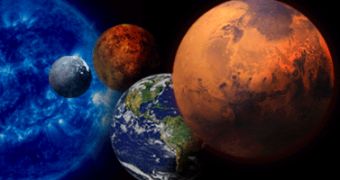The solar system currently consists of four rocky planets and four gas giants, or at least that's what the international scientific community says. Do you notice a pattern? Me neither, not ever since the planet Pluto has been demoted from its status, to the position of minor planet. The four rocky planets in the order from the inner region of the solar system to the outer regions are Mercury, Venus, Earth and Mars.
The only common characteristic of these four celestial bodies is the fact that they are mostly composed of heavy elements, and present a rocky surface, but they are all unique in every way. All are easily visible from the surface of the Earth with the naked eye, and were all known by most of the ancient civilizations. The word 'planet' originally meant in Greek 'lone wonderer', as the ancients observed that not all stars had fixed positions on the night sky, but that some wandered through space.
Mercury is the closest planet to the Sun and the smallest planet in the solar system at the same time. It has a diameter approximated at about 4,878 kilometers, and orbits the Sun from an average distance of about 59 million kilometers roughly equivalent to about a third of the average orbital radius of planet Earth, which results in a Mercuryan year of only 88 Earth days. The planet executes a revolution rotation around its axis every 59 days, which determines long exposures of the surface to the action of the sunlight that heats up the ground to more than 425 degrees Celsius, that's hot enough to melt lead!!! In contrast, the surface of the planet during the so-called Mercuryan night drops below minus 170 degrees Celsius.
Venus is Earth's true sister planet, with a diameter of about 12,104 kilometers, slightly smaller than that of our planet. Venus circles the Sun from a distance of only 108 million kilometers, which determines a Venusian year of about 225 days. In addition to that, Venus presents some usual features such as a spin rotation that is contrary to that of the other planets, and a Venusian day lasts 243 Earth days, which basically means that a day on Venus is almost a year on Earth.
Furthermore, Venus is the closest planet to Earth and routinely passes through the vicinity of our planet at distances as small as 42 million kilometers. Nevertheless, compared to Earth, Venus looks like a word out of a horror movie, with a dense atmosphere composed mostly of carbon dioxide and sulfuric acid that create a runaway green house effect, which heats up the surface to more than 475 degrees Celsius.
Atmospheric pressure is a crushing 90 times that of planet Earth. Due to the heavy atmosphere covering it, most of the observations made from Earth or even from Venus' orbit are close to impossible, thus only a few actual images of the surface exist and have been taken during missions that landed probes on Venus, just before the scorching heat of the planet destroyed their electronic components.
Mars, on the other hand, is the second smallest planet in the solar system, having a diameter less than half of the Earth, and a mass six times smaller. It orbits the Sun from a distance of 228 million kilometers and completes a rotation around it in about 687 Earth days. It has a relatively thin atmosphere and a day that lasts slightly longer than that on Earth. Other similarities to our planet involve the existence of polar caps and the possibility that it might have had liquid water flowing on its surface.
Mars has two small moons, which are actually captured asteroids. The temperatures in the polar regions drop below minus 140 degrees Celsius, during the winter season. Though it presents relatively mild wind gusts, its atmosphere approximated at about 1 percent of that of Earth permits the development of powerful sand storms that rage across its surface on a regular basis.
The ground is filled with scattered craters, signs of possible water erosion, and huge cannions, amongst the largest of which is more than 5,000 kilometers long and 100 kilometers wide. In addition to that, Mars presents evidence of past volcanic activity in the close vicinity of the Mariner valley, where there can be found four giant volcanoes. The largest of them, Mount Olympus, is at least 25 kilometers high, sitting on a platform of more than 600 kilometers in diameter.

 14 DAY TRIAL //
14 DAY TRIAL //